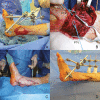The Great Saphenous Vein-An Underrated Recipient Vein in Free Flap Plasty for Lower Extremity Reconstruction: A Retrospective Monocenter Study
- PMID: 36159377
- PMCID: PMC9507579
- DOI: 10.1055/s-0042-1756346
The Great Saphenous Vein-An Underrated Recipient Vein in Free Flap Plasty for Lower Extremity Reconstruction: A Retrospective Monocenter Study
Abstract
Background Reconstruction of large soft tissue defects of the lower extremity often requires the use of free flaps. The main limiting factor and potential for complications lie in the selection of proper donor and recipient vessels for microvascular anastomosis. While the superficial veins of the lower leg are easier to dissect, they are thought to be more vulnerable to trauma and lead to a higher complication rate when using them instead of the deep accompanying veins as recipient vessels. No clear evidence exists that proves this concept. Methods We retrospectively studied the outcomes of 97 patients who underwent free flap plasty to reconstruct predominantly traumatic defects of the lower extremity at our institute. The most used flap was the gracilis muscle flap. We divided the population into three groups based on the recipient veins that were used for microvascular anastomosis and compared their outcomes. The primary outcome was the major complication rate. Results Overall flap survivability was 93.81%. The complication rates were not higher when using the great saphenous vein as a recipient vessel when comparing to utilizing the deep concomitant veins alone or the great saphenous vein in combination to the concomitant veins. Conclusions In free flap surgery of the lower extremity, the selection of the recipient veins should not be restricted to the deep accompanying veins of the main vessels. The superficial veins, especially the great saphenous vein, offer an underrated option when performing free flap reconstruction.
Keywords: free tissue flaps; lower extremity; microsurgery; reconstructive surgical procedures.
The Korean Society of Plastic and Reconstructive Surgeons. This is an open access article published by Thieme under the terms of the Creative Commons Attribution-NonDerivative-NonCommercial License, permitting copying and reproduction so long as the original work is given appropriate credit. Contents may not be used for commercial purposes, or adapted, remixed, transformed or built upon. ( https://creativecommons.org/licenses/by-nc-nd/4.0/ ).
Conflict of interest statement
Conflict of Interest None declared.
Figures

Similar articles
-
Selection of the recipient vein in microvascular flap reconstruction of the lower extremity: analysis of 362 free-tissue transfers.J Plast Reconstr Aesthet Surg. 2011 May;64(5):649-55. doi: 10.1016/j.bjps.2010.07.028. Epub 2010 Aug 21. J Plast Reconstr Aesthet Surg. 2011. PMID: 20727842
-
A comparative study of clinical outcome in ALT free flap reconstruction using superficial or deep and single or dual recipient vein anastomosis in different sites.Microsurgery. 2023 Jul;43(5):490-495. doi: 10.1002/micr.31055. Epub 2023 Jun 22. Microsurgery. 2023. PMID: 37349901
-
Free tissue transfer using bidirectional recipient veins in traumatic extremity reconstruction.Microsurgery. 2024 Jan;44(1):e31084. doi: 10.1002/micr.31084. Epub 2023 Jul 10. Microsurgery. 2024. PMID: 37430144
-
Deep vein thrombosis in donor or recipient veins encountered during lower extremity reconstruction with a free anterolateral thigh perforator flap: How do we deal with it?Front Surg. 2022 Sep 28;9:985245. doi: 10.3389/fsurg.2022.985245. eCollection 2022. Front Surg. 2022. PMID: 36248374 Free PMC article.
-
Both superficial and deep extremity veins can be used successfully as the recipient site for free flaps.Ann Plast Surg. 2000 Jun;44(6):633-6. doi: 10.1097/00000637-200044060-00009. Ann Plast Surg. 2000. PMID: 10884080
References
-
- Gorman P W, Barnes C L, Fischer T J, McAndrew M P, Moore M M. Soft-tissue reconstruction in severe lower extremity trauma. A review. Clin Orthop Relat Res. 1989;(243):57–64. - PubMed
-
- Engel H, Lin C H, Wei F C. Role of microsurgery in lower extremity reconstruction. Plast Reconstr Surg. 2011;127 01:228S–238S. - PubMed
-
- Tomaino M, Bowen V. Reconstructive surgery for lower limb salvage. Can J Surg. 1995;38(03):221–228. - PubMed
-
- Yazar S, Lin C H, Wei F C. One-stage reconstruction of composite bone and soft-tissue defects in traumatic lower extremities. Plast Reconstr Surg. 2004;114(06):1457–1466. - PubMed
-
- Khouri R K, Shaw W W. Reconstruction of the lower extremity with microvascular free flaps: a 10-year experience with 304 consecutive cases. J Trauma. 1989;29(08):1086–1094. - PubMed
LinkOut - more resources
Full Text Sources

